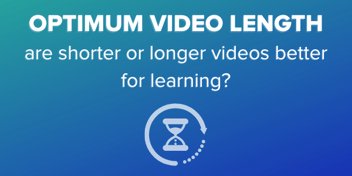When choosing a video to include in your course, there are several factors you’ll want to take into consideration.
Of course, quality is critical. You’ll want the video you have chosen to raise the overall appeal and effectiveness of your course and, for that, you’ll need high-quality content from the likes of Boclips content partners including TED, Crash Course, SciShow, Wonderscape Education, and PBS.
You’ll also want to ensure the video is relevant and that it effectively supports the specific learning objectives you have in mind.
But beyond that, one thing course developers sometimes miss in their hurry to provide value is that less is usually more when it comes to video.
Quality Over Quantity
When creating courses, instructional designers aim to educate students, to solve a specific problem that they’ve been seeking a solution to. Sometimes in a hurry to provide value to students, this objective can be lost. Too often, course developers confuse cramming in more content with delivering more value. The two are not the same thing.
As noted in this article by Rameez Ahmed, students can be overwhelmed by a flood of information. Instead of internalizing what they’re learning, students inundated with information will struggle to retain what they’ve been taught and potentially miss the lesson objective entirely.
Instructional designers need to regularly refer back to learning objectives and consider how best to meet these in the course so that any content being taught is aligned with those learning objectives. In this way, prioritizing information quality over information quantity can help ensure that the content is properly aligned with the learning goals of the curriculum.
Quality is an important consideration when it comes to educational video, but it’s important to consider the attention span of students as well.
How Long Is Too Long?
People today experience numerous competitors for their time and attention which can make people feel short on time. Learners are no different; they want to get to the heart of a lesson as directly and quickly as possible. Lean, well-edited Ed-Ready videos allow them to do this best by emphasizing the right moment in the right video.
This may seem like a sensible conclusion to draw to anyone familiar with education in today’s world, but research also supports this.
One study, done at Suzhou City University in Jiangsu, China, compared student performance on exams between a student population instructed with long-form videos (~55 minutes) and a student population instructed with short-form videos (8 minutes on average). Not only did students from the short video group perform 9% higher on average than students in the long video group, but they also performed well more consistently.
A large-scale study based on 6.9 million video-watching sessions found that student engagement with massive open online course (MOOC) videos had a median engagement time of 6 minutes, regardless of overall video length. The study also found that the shortest videos (0-3 minutes in length) had the highest student engagement levels.
In general, for course developers to maximize the effectiveness of their video content, they should aim to keep their videos at or below 6 minutes. Boclips understands this and 95% of their videos are at or under this magical 6-minute mark.

So, Just Why Is Shorter Better?
The most obvious answer is that our ever-decreasing attention spans are not robust enough to endure anything longer than 360 seconds, but of course, there is a little more to it than that. Shorter videos offer a range of benefits including:
1- Serves Up Bite-Sized Learning
The flexibility that asynchronous learning offers can be a double-edged sword. On the one hand, students can undertake their learning at their own pace which can empower students and help build intrinsic motivation. On the other hand, sporadic and irregularly-paced sessions can break the learning flow and make knowledge retention more challenging for learners.
Shorter educational videos help avoid this by organizing content into bite-sized pieces that learners can easily digest in a single sitting. This contributes to a learner’s overall control of their education and engages them more meaningfully. The research also shows that shorter videos increase the median viewing time in a single sitting. This approach may be recognizable to working professionals who have been advised to break a larger, more intimidating whole into smaller pieces that are easier to deal with one at a time. As the old saying has it, “There’s only one way to eat an elephant; one bite at a time.” The same is true for learners: it’s much easier to internalize knowledge piece by piece than it is to internalize knowledge as one giant monolith of information.
2- Increases Engagement with Post-Video Assessments
Not only does compact video length increase student engagement with the video itself, but students are also significantly more likely to complete any post-video assessment activities when the video is brief.
This helps maintain student engagement with the course content and provides both the student and course moderator with feedback on the student’s progress throughout the course.
3- Makes the Most of the Learning Time Available
Shorter video lessons and materials can often seem ill-fitting for the traditional hour-long lecture format of traditional classroom learning. This can make the benefits of shorter educational videos in the classroom harder to recognize. Instructional designers sometimes have difficult work ahead of them in convincing educators of the value of short Ed-Ready videos.
In the context of synchronous classroom learning, it can make sense to cram as much content as possible into each learning session. Halls and classrooms must be booked, students and instructors have to travel to and from the venue, and relevant resources and materials need to be organized and distributed ahead of time. There’s a huge time and energy investment required to overcome these and other logistical problems in making a class in any way functional. In this headspace, it makes sense to have longer sessions that make the most of that time and energy investment.
It’s easy to be trapped in this limiting mindset. Asynchronous learning outside the classroom requires no such time/energy investment on the part of the student or instructor. Learning session duration can be boiled down to a concern about efficacy and when it comes to educational videos for the classroom, shorter usually means better.
4- Increases Perceived Course Value
In a world where the internet is chock-a-block with free blog articles, research papers, and informative PDFs all available at the click of a mouse, text on its own just doesn’t have the currency or value it once did. Research on educational videos in the classroom indicates that lessons taught with video support lead to better performance on exams than lessons taught without video support. This means that any class leveraging educational videos has a higher perceived value to the student than classes that rely on text alone. There’s no doubt about it: educational videos in the classroom can promise a stronger academic performance for students.

Video in the classroom has evident cache and value in the education world. That’s especially true of high-quality proprietary video such as those curated by Boclips. While the inclusion of video itself can increase the perceived value of a course, short videos in particular add more bang-for-your-buck. A course that boasts nine 5-minute videos is always going to feel more valuable than a course that contains a single 45-minute video. Even though the cumulative amount of video content is the same, breaking up a larger video into smaller clips offers more advantages to students.
So, Does One Size Fit All?
While the research clearly shows that short videos provide more benefit for learners and instructional designers alike, there are times when selecting a video longer than six minutes may be warranted.
According to research undertaken by VA Boston Healthcare System and Harvard University, a person’s attention span tends to increase with age, up to a peak at around 43 years old. This indicates that older learning populations may feel less challenged by longer educational videos. However, instructional designers are not in the business of testing human mental endurance.
Perhaps the adage, “Just because you can, does not mean you should” could apply here; yes, learners of older ages can retain information from longer videos, but should they have to? Available research indicates a clear trend: shorter chunks of information are easier to digest and easier to retain. Learners of all ages benefit from learning a larger thing through smaller pieces. The needs of our audience and their learning objectives are our main considerations. When it comes to choosing educational videos for the classroom, shorter videos are better for everyone.
The good news is that the Boclips is full of short-form, Ed-Ready videos from some of the world’s best providers. All videos are rights-cleared for educational purposes so you don’t need to worry about copyright headaches. Whether sharing video in the classroom, or purchasing video for courseware or curriculum materials, or integrating into an application, explore our 2.2M videos videos for free.
Boclips
Boclips is on a mission to make learning more captivating with video with an easier, safer way to access videos from the world’s leading video producers.
- #Classroom
- #Video in Digital Learning
- #Educational Videos
- #Tips for Using Video
- #Video Content Partners
- #Boclips for Publishers
- #Issues in Education
- #Educational Videos by Subject Area
- #News and Announcements
- #Events & Holidays
- #Video and Teaching Tools
- #Teaching Methodologies
- #Education Videos
- #Video and Digital Literacy
- #Short Educational Videos
- #Instructional Design
- #Multimodal Learning
- #Video and Student Safety
- #Accessibility in Education
-3.png?width=390&height=223&name=Untitled%20design%20(2)-3.png)


.png?width=1152&height=660&name=Copy%20of%20Untitled%20Design%20(1).png)



